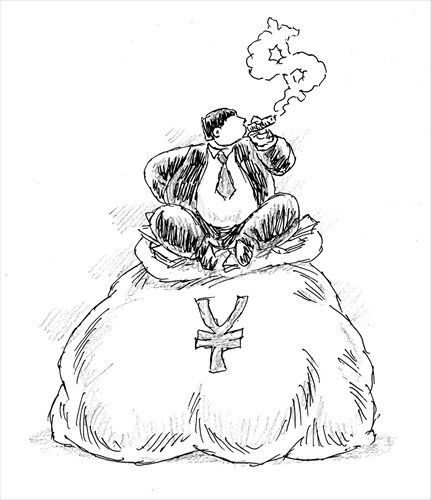Can China join high-income group in 10 years?

Illustration: Peter C. Espina/GT
Some people have been contemplating as to when China will become a high-income economy. They tend to believe that once China joins the high-income group, it would have avoided the middle-income trap and turned itself into a developed country. In fact, such thinking reflects some misunderstanding.
As of July 1, 2015, the World Bank classifies middle-income economies as those with a gross national income (GNI) per capita of more than $1,045 but less than $12,736; and high-income economies as those with a GNI per capita of $12,736 or more.
If calculated based on China's 2015 GDP at the yuan exchange rate of 6.2 per dollar, China's GNI per capita is less than $8,000. So, will China become a high-income economy in 10 years' time? Not necessarily, because even if China's GNI per capita reaches $12,736 in 10 years, the World Bank is also likely to elevate its threshold for high-income economies. In order to become a high-income country, China faces three main obstacles.
The first obstacle is sustaining its GDP growth at around 6 percent. This depends on three factors. The first factor is population, as it determines labor supply and consumer demand; the second is the alignment of different factors of production; and the third is the global economic situation. For now, none of the three factors appear to be positive.
The second obstacle lies in whether the yuan exchange rate can remain stable. As China's broad money (M2) supply is expanding at a fast pace, it is still doubtful whether the yuan exchange rate against the dollar can be maintained within 7.00. The third obstacle is that the threshold for a high-income economy is expected to rise in the coming decade because of the expansionary monetary policies of different countries, hence a conservative estimate would put the high-income threshold at $14,000 in a decade.
China's high-speed GDP growth mainly relied on the rise of the secondary industry before 2000. During that period, China's manufacturing industry seized the opportunity when developed economies were transferring their manufacturing business overseas, while China was opening up and had abundant supply of cheap labor. A booming real estate industry has become another key driver of growth along with manufacturing since 2000, which is a similar model to economies having successfully completed their economic transitions.
But there is a key difference between China and other economies in achieving high GDP growth - China has relied too much on investment. World Bank statistics show that China's gross capital formation (GCF) in 2014, also known as gross domestic investment, accounted for 46 percent of the GDP of that year. It was roughly two times the average of developed economies, and much higher than developing economies.
Furthermore, neither the quality of economic growth nor the quality of investment is high. China's fixed-assets investment (FAI) in 2015 totaled 56.2 trillion yuan ($8.7 trillion), accounting for 83 percent of the GDP of 67.7 trillion yuan. But the GCF-to-GDP ratio in 2015 was only 43.8 percent, according to official statistics. Thus the amount of the overall FAI was roughly 26.6 trillion yuan higher than the GCF in 2015.
In theory, FAI is similar to GCF, and under normal circumstances, there should only be a small disparity between the two. As investment in intangible assets is not included in FAI but is included in GCF, it's quite common if GCF is bigger than FAI in scale.
Then why has China's FAI scale significantly exceeded its GCF scale since 2004? One reason could be associated with inflated figures, or "grey income" due to embezzlement of investment capital.
As for the reasons behind inflated investments, local governments might be doing it to boost achievement, while firms might be raising funds without directing them into the real economy.
At present, even though the GCF-to-GDP ratio, FAI growth and M2 growth have all decelerated, they are still huge in volume. This suggests that dependence on investment and monetary expansion to prop up the GDP growth cannot last long, and its costs will be enormous. Hence, it's not difficult to trace China's problems to the very process of high GDP growth. High growth could boost investment enthusiasm and lead to loose monetary policy and increased leverage. As capital is directed less into the real economy and more into the financial market, asset bubbles could develop, which could lead to inflation and currency depreciation.
Moreover, even though China has been emphasizing that the economy should be innovation-driven, its proportion of high-tech investment is too low, suggesting it is still far away from truly becoming an innovation-driven economy.
We should stand in awe of the market. Economic policies that are reactionary might be effective in the short run, but are ineffective in the long run. Besides, there are serious side-effects of such policies in the long run. Even if China's GDP exceeds that of the US, it would still lag behind these economies in many other aspects. Frankly speaking, China has already done a terrific job following its opening up. As long as the economy continues to be human-centered and strives to narrow the gap between the rich and poor, Chinese people will be satisfied enough to live in a moderately prosperous society.
The author is chief economist at Haitong Securities, bizopinion@globaltimes.com.cn